初中三年英语语法
- 格式:doc
- 大小:45.50 KB
- 文档页数:6
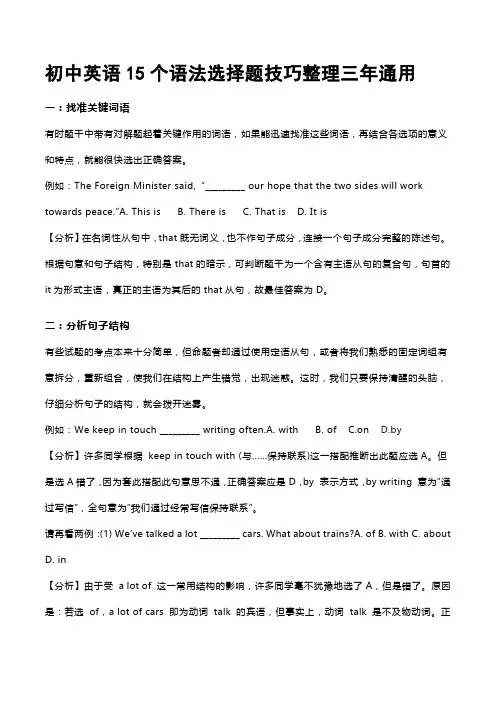
初中英语15个语法选择题技巧整理三年通用一:找准关键词语有时题干中带有对解题起着关键作用的词语,如果能迅速找准这些词语,再结合各选项的意义和特点,就能很快选出正确答案。
例如:The Foreign Minister said, “_________ our hope that the two sides will work towards peace.”A. This is B. There is C. That is D. It is【分析】在名词性从句中,that既无词义,也不作句子成分,连接一个句子成分完整的陈述句。
根据句意和句子结构,特别是that的暗示,可判断题干为一个含有主语从句的复合句,句首的it为形式主语,真正的主语为其后的that从句,故最佳答案为D。
二:分析句子结构有些试题的考点本来十分简单,但命题者却通过使用定语从句,或者将我们熟悉的固定词组有意拆分,重新组合,使我们在结构上产生错觉,出现迷惑。
这时,我们只要保持清醒的头脑,仔细分析句子的结构,就会拨开迷雾。
例如:We keep in touch _________ writing often.A. with B. of C.on D.by【分析】许多同学根据keep in touch with (与……保持联系)这一搭配推断出此题应选A。
但是选A错了,因为套此搭配此句意思不通,正确答案应是D,by 表示方式,by writing 意为“通过写信”,全句意为“我们通过经常写信保持联系”。
请再看两例:(1) We’ve talked a lot _________ cars. What about trains?A. of B. with C. about D. in【分析】由于受 a lot of 这一常用结构的影响,许多同学毫不犹豫地选了A,但是错了。
原因是:若选of,a lot of cars 即为动词talk 的宾语,但事实上,动词talk 是不及物动词。
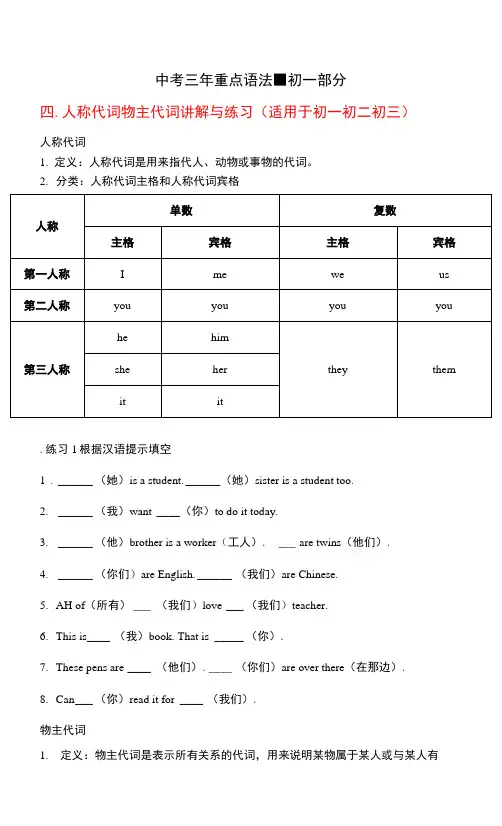
中考三年重点语法■初一部分四.人称代词物主代词讲解与练习(适用于初一初二初三)人称代词1.定义:人称代词是用来指代人、动物或事物的代词。
2.分类:人称代词主格和人称代词宾格.练习1根据汉语提示填空1. ______ (她)is a student. ______(她)sister is a student too.2. ______ (我)want ____ (你)to do it today.3. ______ (他)brother is a worker(工人). ___ are twins(他们).4. ______ (你们)are English. ______ (我们)are Chinese.5.AH of(所有)___ (我们)love ___ (我们)teacher.6.This is ____ (我)book. That is _____ (你).7.These pens are ____ (他们). ____ (你们)are over there(在那边).8.Can ___ (你)read it for ____ (我们).物主代词1.定义:物主代词是表示所有关系的代词,用来说明某物属于某人或与某人有关。
练习1根据汉语意思补全句子.1. This is _______ f ather.这是我的爸爸。
2. Is that bike ______ ? Yes,ifs ________ .那辆自行车是你的吗?是,它是我的。
3.______ like ______ car.我喜欢他们的小汽车。
4. Our school is here, and _______ i s there.我们的学校在这儿,他们的在哪儿。
5. Whose bike is this ?It's _______ (=It's _______ ),这是谁的自行车?是她的吗?6. Is that car _______ ? Yes,it,s ______ .那辆车是你的吗?是的,它是我的练习2.I•选择填空1. He is ________ (our/ours) English teacher. ________ name is Sam (男人名).2.____________________________________________ Jane (女人名)is my friend. She has got long hair. _______________________________________ hair is yellow.But _________ (my/mine) is black.3._______ (mine/my) dog is white .But __________ (her/hers) is black.4.—Whose computer is it ? Is it your father's ? —No,it's not_________ .It's my mother's. - Oh, it's ____________ . (it's = ______ )5.― Look ! _________ car is it ? Is it _______ (your/yours) ?-No, __________ (our/ours) car is old (旧的).—Ifs _________ (their/theirs) car . ________ is new.II .用括号中单词的适当形式填空1 . —Arc these ___________ (you) pencils ? — Yes ,thcy are ________ (our).2. -Whose pencil is this ?一It's __________ (I).3.She is _________ (I) friend.4.Miss Li oftenJ.Q£)k .after/照顾) ______ (she) brother.5.一Are these _______ (they) bags ?—No,they aren't ________ (their). They arc _____ (wc). (aren't = _______________ )6f.Thi§ bike is my sister's . It is ________ (she).7._____________ This isn't _________ (I) book . ________________________ (my) is in the bag. (is't = _____________ )III.填入正确的人称代词和物主代词1. This isn't _______ k nife. ________ is green, (she)2. These are your books, Kate. Put ______ i n de desk,please, (they)3.______ must look after (照顾) _______ t hings, (you )4. Wei Fang, is that________ ruler ? Yes, it's . (you)5. They want(想要)a football . Give _______ the green one. Please, (they)6. It's Lin Tao's bag . Give it to ________ . (he)7. Is this pencil-box Li Lei's ? No, _______ is very(非常)new.(he)8. This box is I QQ J顶戏、(彳艮重).I can't carry(携带) .(it) (can't = ____________ )Don't worry ,Let _______ (I) help _______ . (you)9. ______ is a boy. ______ name is Mike(男人名).Mike's friends like veryimch(非常).(he)10.My sister is in _____ room. _______ is a teacher, (she)11.Jane is a little girl. _____ mother is a nurse(护士). (she)12.We are in _____ classroom. ______ classroom is bag. (we)13.My father and mother are teachers. _______are busy(繁忙).(them)14.You are a pupil(儿童).Is _____ brother a pupil, too ? (you)15.I ate(eat 的过去分词)all _________ sandwiches yesterday. (I) Can I have oneof _______ .(they)16.Jack(男人名)has a dog and_so…have 1(我也有一只). _____ (he)dog and _____ ⑴had a fight(打架).17.G顷ge(男人名)hasksK 丢失了) ________(his) pen. Ask M&M女人名)if (是否)she will 蚣ndt借)him _____ .(she)18.The teacher wants you to return that book of _________ .(he)19.Mr and Mrs. Green(男人名)and a friend of _________ are coming to see us, (they)20.We are going to Paris(巴黎)to stay with a French(法国)friend of __________ (we). V.补全对话1 .——Whose bike is it ? Is it ______ (your/yours)?——No,it's not ____ .(my/mine) __________ is red. But this bike is blue .——Is it Jane's ?——Sorry, I don't know. Maybe it's _______.----Jane,is this _____ bike ?-…No,it's not_____ .You can ask Bill(男人名).Maybe it's ________ .——Bill,is this bike _____ ?——Oh,yes,it's ______ bike.Thank you very mnch!2. ——Whose classroom is it ? Is it __________(our/ours)classroom ?——No,it's not ______ . It's __________ (their/theirs)——_______ (their/theirs) classroom is big.——Yes ,you are right.-・一But ___ is small.VI.根据句意用适当人称代词、物主代词填空1 . Mary works in a bookstore(书店). _______likes _____ work very mneh.2 . Jone and I are in the5ame (相同的)school. _______ g o to school iQgether (—起).3 . She is a friend of_______ . We got to know each Wh 以(彼此、互相)two years ago.4 . Her sister makes all ____ own (自己的)dresses.5 . I have many friends. ______ are all gQQd 硕擅长于)English.6 .——May I use (使用) ___ bike ?---- ______ is broken (故障、坏的).VIII.选择2. Whose pen is it? It's4. This room is ours, and that one is5. Whose pencils are there? They'reA. you, meB. yours, mineC. your, my 7. Whose shoes are these? They are8. She is a student, name is Han Mei.9. It's a dog. I don't know1. This is my book. are over there.A. YourB. YoursC. YouD. Mine A. myB. meC. mineD. our6. Is the new watch.? Yes, it'sA. meB. mineC. myD. I A. its B. her C. hers D. his A. its' B. itsC. itD. ifsA. herB. hersC. sheD. his3.bag is new andis new, loo.A. Our, heB. Ours, hisC. My, hisD. My, her A. theyB. themC. theirsD. theirD. your, mine name.10. This ruler isn't mine. I think it is ____11. ___ schoolbag is beautiful. But ____ is more beautiful. B. Jim's, mine D. Jims', I12. __ am a boy and _____ is a girl. A. My, she B. I, her C. I, she D. Mine, she 13.1 like ___ new dress. A. She B. her C. hers D. his mother do housework (家务活)°A. me, sheB. mine, herC. my, herD. I, hers 15.1s that ___ hat? No, ifs not _______ .It's ____ .A. heB. himC. hisD. herA. Jims, my C. Jim's, me14.1 often helpA. your, my, Toms C.yours, mine, TomB. you, mine, Toni's D.your, mine, Tom's。
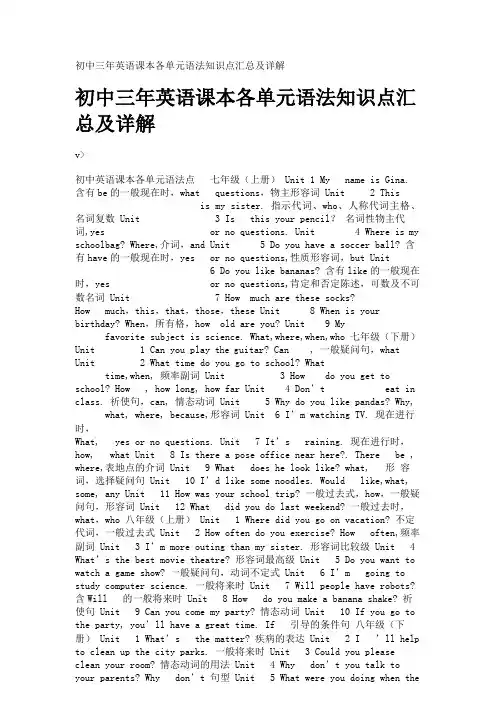
初中三年英语课本各单元语法知识点汇总及详解初中三年英语课本各单元语法知识点汇总及详解v>初中英语课本各单元语法点七年级(上册) Unit 1 My name is Gina. 含有be 的一般现在时,what questions,物主形容词 Unit 2 Thisis my sister. 指示代词、who、人称代词主格、名词复数 Unit 3 Is this your pencil?名词性物主代词,yes or no questions. Unit 4 Where is my schoolbag? Where,介词,and Unit 5 Do you have a soccer ball? 含有have 的一般现在时,yes or no questions,性质形容词,but Unit6 Do you like bananas? 含有like 的一般现在时,yes or no questions,肯定和否定陈述,可数及不可数名词 Unit7 How much are these socks?How much,this,that,those,these Unit 8 When is your birthday? When,所有格,how old are you? Unit 9 Myfavorite subject is science. What,where,when,who 七年级(下册)Unit 1 Can you play the guitar? Can , 一般疑问句,what Unit 2 What time do you go to school? Whattime,when, 频率副词 Unit 3 How do you get to school? How , how long, how far Unit 4 Don’t eat in class. 祈使句,can, 情态动词 Unit 5 Why do you like pandas? Why, what, where, because,形容词 Unit 6 I’m watching TV. 现在进行时,What, yes or no questions. Unit 7 It’s raining. 现在进行时,how, what Unit 8 Is there a pose office near here?. There be , where,表地点的介词 Unit 9 What does he look like? what, 形容词,选择疑问句 Unit 10 I’d like some noodles. Would like,what, some, any Unit 11 How was your school trip? 一般过去式,how,一般疑问句,形容词 Unit 12 What did you do last weekend? 一般过去时,what,who 八年级(上册) Unit 1 Where did you go on vacation? 不定代词,一般过去式 Unit 2 How often do you exercise? How often,频率副词 Unit 3 I’m more outing than my sister. 形容词比较级 Unit 4 What’s the best movie theatre? 形容词最高级 Unit 5 Do you want to watch a game show? 一般疑问句,动词不定式 Unit 6 I’m going to study computer science. 一般将来时 Unit 7 Will people have robots? 含Will 的一般将来时 Unit 8 How do you make a banana shake? 祈使句 Unit 9 Can you come my party? 情态动词 Unit 10 If you go to the party, you’ll hav e a great time. If 引导的条件句八年级(下册) Unit 1 What’s the matter? 疾病的表达 Unit 2 I ’ll help to clean up the city parks. 一般将来时 Unit 3 Could you please clean your room? 情态动词的用法 Unit 4 Why don’t you talk to your parents? Why don’t 句型 Unit 5 What were you doing when therainstorm came? 过去进行时,when 与while 引导的时间状语从句 Unit 6An old man tried to move the mountains. 动词不定式 Unit 7W hat’s the highest mountain in the world? 形容词/副词的最高级Unit 8 Have you read Treasure Island yet? 现在完成时 Unit 9 Have you ever been to a museum? 现在完成时Unit10 I’ve had this bike for three years. 现在完成时(延续性和非延续性动词)九年级(全册) Unit 1 How can we become good learners? 动词+by+动名词Unit 2 I think that mooncakes are delicious! 宾语从句:that,if/whether Unit 3 Could you please tell me wherethe restaurants are? 宾语从句:wh- Unit 4 I used to be afraid of the dark. used to Unit 5 What are the shirts made of ? 被动语态:一般现在时 Unit 6 When was it invented ? 被动语态:一般过去时Unit 7 Teenagers should be allowed to choose their own clothes. 被动语态:含情态动词 Unit 8 It must belong to Caral. 表推测的情态动词:must,might,could,can\\\\\\\'t Unit 9 I like music that I can dance to. 定语从句:that/which,who Unit 10 You are supposed to shake hands. be supposed to+do Unit 11 Sad movies make me cry. make sb.do/make sb.+adj. Unit 12 Life isfull of the unexpected. 综合复习【时态、状语从句】、过去完成时Unit 13 We\\\\\\\'re trying to save the earth! 综合复习【时态、被动语态、used to、情态动词】 Unit 14 I remember meeting all of you in Grade 7. 综合复习初中英语语法详解初中英语课本各单元语法点七年级(上册) Unit 1 My name is Gina. 含有be 的一般现在时,what questions,物主形容词 Unit 2 This is my sister. 指示代词、who、人称代词主格、名词复数 Unit 3 Is this your pencil?名词性物主代词,yes or no questions. Unit 4 Where is my schoolbag? Where, 介词,and Unit 5 Do you have a soccer ball? 含有have 的一般现在时, yes or no questions,性质形容词,but Unit6 Do you like bananas? 含有like 的一般现在时,yes or no questions,肯定和否定陈述,可数及不可数名词 Unit7 How much are these socks? How much,this, that,those,these Unit8 When is your birthday? When,所有格,how old are you? Unit 9 My favorite subject is science. What,where,when,who 七年级(下册) Unit 1 Can you play the guitar? Can , 一般疑问句,what Unit 2 What time do you go to school? What time,when, 频率副词 Unit 3 How do you get to school?How , how long, how far Unit 4 Don’t eat in class. 祈使句,can, 情态动词 Unit 5 Why do you like pandas? Why, what, where, because,形容词 Unit 6 I’m watching TV. 现在进行时,What, yes or no questions. Unit 7 It’s raining. 现在进行时,how, what Unit 8 Is there a pose office near here?. Therebe , where,表地点的介词 Unit 9 What does he look like? what,形容词,选择疑问句Unit 10 I’d like some noodles. Wouldlike,what, some, anyUnit 11 How was your school trip? 一般过去式,how,一般疑问句,形容词 Unit 12 What did you do last weekend? 一般过去时,what,who 八年级(上册) Unit 1 Where did you go on vacation? 不定代词,一般过去式 Unit 2 How often do you exercise? How often,频率副词Unit 3 I’m more outing than my sister. 形容词比较级 Unit 4 What’s the best movie theatre? 形容词最高级 Unit 5 Do you want to watch a game show? 一般疑问句,动词不定式 Unit 6 I’m going to study computer science. 一般将来时 Unit 7 Will people have robots? 含Will 的一般将来时 Unit 8 How do you make a banana shake? 祈使句 Unit 9 Can you come my party? 情态动词 Unit 10 If you go to the party, you’ll have a great time. If引导的条件句八年级(下册) Unit 1 What’s the matter? 疾病的表达 Unit 2 I ’ll help to clean up the city parks. 一般将来时 Unit 3 Could you please clean your room? 情态动词的用法 Unit 4 Why don’t you talk to your parents? Why don’t 句型 Unit 5 What were you doing when the rainstorm came? 过去进行时,when 与while 引导的时间状语从句 Unit 6 An old man tried to move the mountains. 动词不定式 Unit 7W hat’s the highest mountain in the world? 形容词/副词的最高级Unit 8 Have you read Treasure Island yet? 现在完成时 Unit 9Have you ever been to a museum? 现在完成时Unit10 I’ve had this bike for three years. 现在完成时(延续性和非延续性动词)九年级(全册) Unit 1 How can we become good learners? 动词+by+动名词Unit 2 I think that mooncakes are delicious! 宾语从句:that,if/whether Unit 3 Could you please tell me wherethe restaurants are? 宾语从句:wh- Unit 4 I used to be afraid of the dark. used to Unit 5 What are the shirts made of ? 被动语态:一般现在时 Unit 6 When was it invented ? 被动语态:一般过去时Unit 7 Teenagers should be allowed to choose their own clothes. 被动语态:含情态动词 Unit 8 It must belong to Caral. 表推测的情态动词:must,might,could,can\\\\\\\'t Unit 9 I like music that I can dance to. 定语从句:that/which,who Unit 10 You are supposed to shake hands. be supposed to+do Unit 11 Sad movies make me cry. make sb.do/make sb.+adj. Unit 12 Life isfull of the unexpected. 综合复习【时态、状语从句】、过去完成时Unit 13 We\\\\\\\'re trying to save the earth! 综合复习【时态、被动语态、used to、情态动词】 Unit 14 I remember meetingall of you in Grade 7. 综合复习。
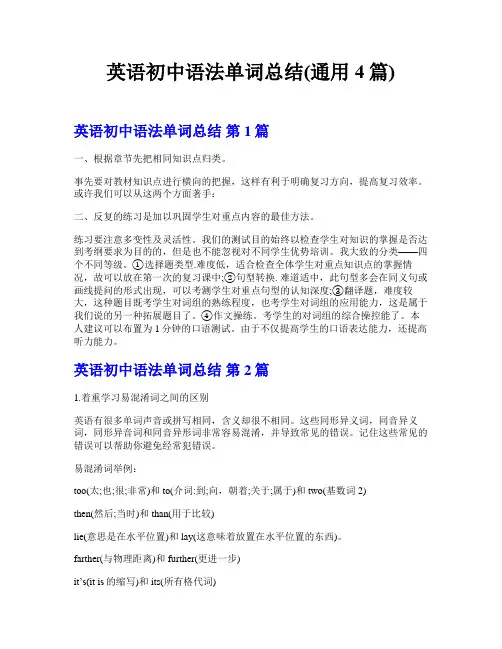
英语初中语法单词总结(通用4篇)英语初中语法单词总结第1篇一、根据章节先把相同知识点归类。
事先要对教材知识点进行横向的把握,这样有利于明确复习方向,提高复习效率。
或许我们可以从这两个方面著手:二、反复的练习是加以巩固学生对重点内容的最佳方法。
练习要注意多变性及灵活性。
我们的测试目的始终以检查学生对知识的掌握是否达到考纲要求为目的的,但是也不能忽视对不同学生优势培训。
我大致的分类——四个不同等级。
①选择题类型.难度低,适合检查全体学生对重点知识点的掌握情况,故可以放在第一次的复习课中;②句型转换. 难道适中,此句型多会在同义句或画线提问的形式出现,可以考测学生对重点句型的认知深度;③翻译题,难度较大,这种题目既考学生对词组的熟练程度,也考学生对词组的应用能力,这是属于我们说的另一种拓展题目了。
④作文操练。
考学生的对词组的综合操控能了。
本人建议可以布置为1分钟的口语测试。
由于不仅提高学生的口语表达能力,还提高听力能力。
英语初中语法单词总结第2篇1.着重学习易混淆词之间的区别英语有很多单词声音或拼写相同,含义却很不相同。
这些同形异义词,同音异义词,同形异音词和同音异形词非常容易混淆,并导致常见的错误。
记住这些常见的错误可以帮助你避免经常犯错误。
易混淆词举例:too(太;也;很;非常)和to(介词:到;向,朝着;关于;属于)和two(基数词2)then(然后;当时)和than(用于比较)lie(意思是在水平位置)和lay(这意味着放置在水平位置的东西)。
farther(与物理距离)和further(更进一步)it’s(it is的缩写)和its(所有格代词)they’re(they are的缩写)和their(所有格代词),there(表示地点的副词)you’re(you are的缩写)和your(所有格代词)2.正确使用标点符号标点符号是语言的重要组成部分,它标明了句子的开始,停止,暂停,和句与语之间的关系。
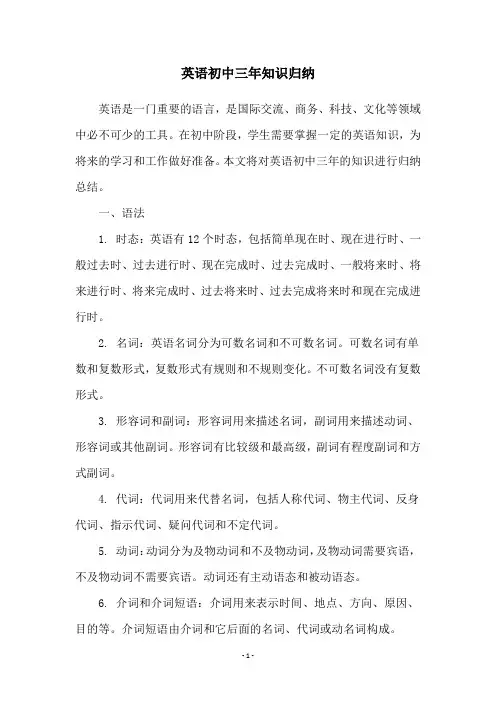
英语初中三年知识归纳英语是一门重要的语言,是国际交流、商务、科技、文化等领域中必不可少的工具。
在初中阶段,学生需要掌握一定的英语知识,为将来的学习和工作做好准备。
本文将对英语初中三年的知识进行归纳总结。
一、语法1. 时态:英语有12个时态,包括简单现在时、现在进行时、一般过去时、过去进行时、现在完成时、过去完成时、一般将来时、将来进行时、将来完成时、过去将来时、过去完成将来时和现在完成进行时。
2. 名词:英语名词分为可数名词和不可数名词。
可数名词有单数和复数形式,复数形式有规则和不规则变化。
不可数名词没有复数形式。
3. 形容词和副词:形容词用来描述名词,副词用来描述动词、形容词或其他副词。
形容词有比较级和最高级,副词有程度副词和方式副词。
4. 代词:代词用来代替名词,包括人称代词、物主代词、反身代词、指示代词、疑问代词和不定代词。
5. 动词:动词分为及物动词和不及物动词,及物动词需要宾语,不及物动词不需要宾语。
动词还有主动语态和被动语态。
6. 介词和介词短语:介词用来表示时间、地点、方向、原因、目的等。
介词短语由介词和它后面的名词、代词或动名词构成。
7. 连词:连词用来连接单词、短语、句子等,包括并列连词、从属连词和关系连词。
二、单词1. 基础词汇:初中阶段需要掌握大量的基础词汇,包括常见的名词、动词、形容词、副词、介词、连词等。
2. 词根和词缀:词根是单词的核心部分,词缀是附加在词根上的字母。
掌握词根和词缀可以帮助学生更好地理解和记忆单词。
3. 短语和习惯用语:短语和习惯用语是英语中常见的固定搭配,掌握这些短语和习惯用语可以提高学生的语言表达能力。
4. 同义词和反义词:同义词是指意思相同或相近的单词,反义词是指意思相反的单词。
掌握同义词和反义词可以丰富学生的词汇量。
三、阅读1. 理解文章:初中阶段需要学生阅读各种类型的文章,并理解文章的主旨、段落结构、语言风格等。
2. 阅读技巧:阅读技巧包括预测、扫读、略读和详读等,可以帮助学生更好地理解文章。
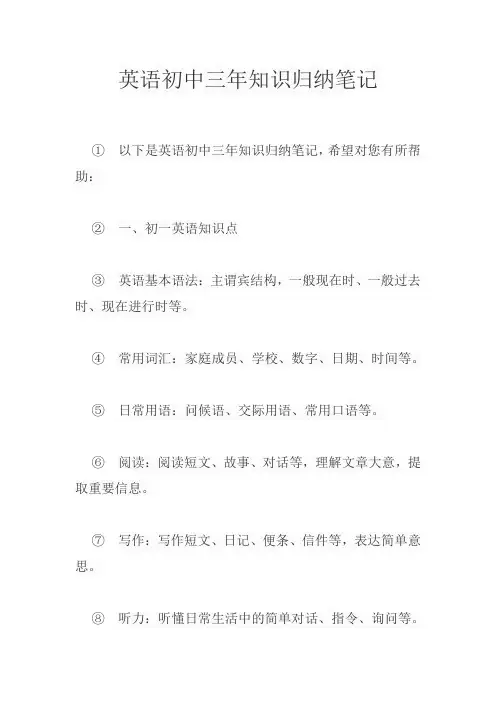
英语初中三年知识归纳笔记
①以下是英语初中三年知识归纳笔记,希望对您有所帮助:
②一、初一英语知识点
③英语基本语法:主谓宾结构,一般现在时、一般过去时、现在进行时等。
④常用词汇:家庭成员、学校、数字、日期、时间等。
⑤日常用语:问候语、交际用语、常用口语等。
⑥阅读:阅读短文、故事、对话等,理解文章大意,提取重要信息。
⑦写作:写作短文、日记、便条、信件等,表达简单意思。
⑧听力:听懂日常生活中的简单对话、指令、询问等。
⑨二、初二英语知识点
⑩英语语法:情态动词、被动语态、虚拟语气等。
11词汇:形容词、副词、连词、介词等。
12口语表达:电话、邀请、建议、请求等。
13阅读:阅读简单文学作品、新闻报道、广告等,理解文章细节、主旨。
14写作:写作短文、读后感、议论文等,表达清晰思路,语言流畅。
15听力:听懂日常对话、短文、广播、新闻等。
16三、初三英语知识点
17英语语法:复合句、定语从句、名词性从句等。
18词汇:动词短语、介词短语、熟语、惯用语等。
19口语表达:讨论、辩论、发言等。
20阅读:阅读较长篇幅的文学作品、新闻报道、广告等,分析文章结构和风格,掌握阅读策略。
21写作:写作议论文、作文等,能够准确表达观点,文笔流畅,结构合理。
22听力:听懂较长篇幅的对话、新闻、演讲等。
23以上是初中三年英语知识点的简要归纳,具体内容还需结合教材和教学要求进行深入学习和掌握。
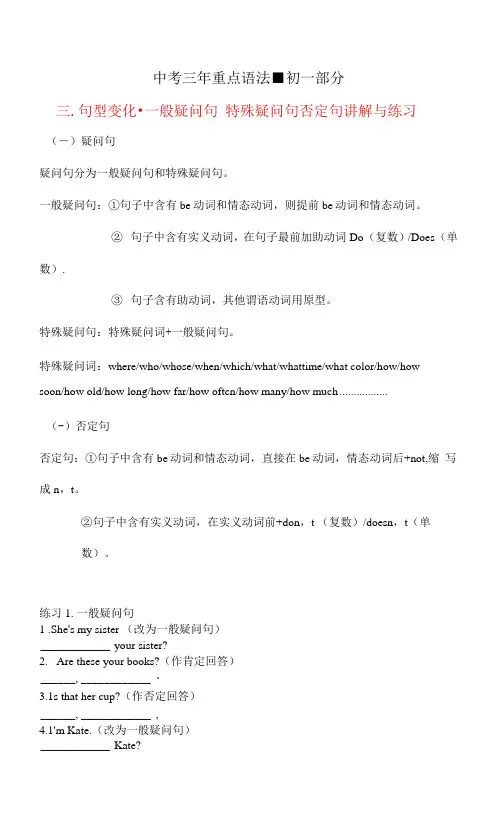
中考三年重点语法■初一部分三.句型变化•一般疑问句特殊疑问句否定句讲解与练习(―)疑问句疑问句分为一般疑问句和特殊疑问句。
一般疑问句:①句子中含有be动词和情态动词,则提前be动词和情态动词。
②句子中含有实义动词,在句子最前加助动词Do (复数)/Does (单数).③句子含有助动词,其他谓语动词用原型。
特殊疑问句:特殊疑问词+一般疑问句。
特殊疑问词:where/who/whose/when/which/what/whattime/what color/how/howsoon/how old/how long/how far/how oftcn/how many/how much .................(-)否定句否定句:①句子中含有be动词和情态动词,直接在be动词,情态动词后+not,缩写成n,t。
②句子中含有实义动词,在实义动词前+don,t (复数)/doesn,t(单数)。
练习1.一般疑问句1 .She's my sister (改为一般疑问句)____________ your sister?2.Are these your books?(作肯定回答)______, ____________ ・3.1s that her cup?(作否定回答)______, ____________ ,4.1'm Kate.(改为一般疑问句)____________ Kate?5.Are you in China?(作肯定回答)_____ J _______ •6.We often talk about our hobbies.(改为一般疑问句7.1like running and jumping.(改为一般疑问句) 8.She comes back home at 6 pm .(改为一般疑问句)9.Daniel has lots of homework,(改为一般疑问句)lO.Lily and I go to school on foot,(改为一般疑问句)1 l.We all have a good time today.(改为一般疑问句)12.His teacher always reads stories in class.(改为一般疑问句)13.1went to Nanjing with my brother last week.(改为一般疑问句)14.He always reads books before bedtime.(改为一般疑问句)15.My uncle teaches English in our school,(改为一般疑问句)16.Lily went to hospital to look after her grandfather last Sunday.(改为一般疑问句)17.Tim's brother seldom goes shopping with us.(改为一般疑问句)18.The little dog lost its way.(改为一般疑问句)19.We bought some gifts for our teachers.(改为一般疑问句)2O.They love going swimming very much,(改为一般疑问句)2l.His mum often brings nice sweets for us.(改为一般疑问句)22.Thc kite flics high in the sky,(改为一般疑问句)23.All of us saw that strange man in our school.(改为一般疑问句)24.Bob and I got the same points.(改为一般疑问句)25.1usually have breakfast at 7o'clock in the morning.(改为一般疑问句)26.She does her homework carefully.(改为一般疑问句)19.Can you sing ?(作否定回答)______ ,I ________20. Does he like speaking English?(作肯定回答) ___ ,he ____________21. Can Jane speak Chinese?(否定回答) ___ , ___________22. Is this boy your brother?(做肯定回答) ____ , _________23. Arc those her books?(做否定回答) ____ , ___________练习 2.Fill in the blanks with question words 用疑问词填空1. - ________ do you like Friday? -Because I have art and P.E.2. - _______ likes singing and dancing? -Lucy does.3. - _______ is your father's favorite sport? -Running.4. - _______ is your weekend? -It's great.5. - _______ is your School Day? -It's on October 28th.6. - _______ are you, Lingling? -I'm fine. Thank you very much.7. - _______ is your new iPad? -It is about 1,800 yuan.8. - _______ do you want to have for lunch? -I want to have some bread.9. - _______ is the girl in yellow? -She is nine years old.10. - ______ is your computer? -It is on the sofa.Write questions according to the answers 根据答语写出问句20. - _______ is this pair of pants? -It's 8() yuan.A. How manyB. How longC. How muchD. How often21. - _______ is the boy with a ball? -He is my brother.11, _________________________ 12. - ___________________________ 13. - ___________________________ 14. - ___________________________ 15. - ___________________________ 16. - ___________________________ 17. - ___________________________ 18. - ___________________________Single choice 单项选择19. - ________ your English books?A. Where'sB. Where are -My bag is under the chair.-My sister is only five.-My favorite star is Li Na.-Because I think red can make me lucky.-This pencil box is 5 yuan.-It's a book.-Chen Xiao's birthday is on July Sth, 1987.-My favorite subject is music. -On the sofa. C. What'sA. WhereB. WhatC. Who22.- _______ do you like history? -Because it is interesting.A. WhenB. HowC. WhereD. Why23.- _______ are the white hats? -They are on sale, only 15 yuan.A. How muchB. How oldC. How longD. How about Rewrite the sentences as required 按要求改写句子24.The pencil is blue.(对画线部分提问)________________ is the pencil?25.My pants are 15 dollars.(对画线部分提问)________________ are your pants?26.Li Hui is 13 years old.(对画线部分提问)________________ is Li Hui?27.That girl is my cousin.(对画线部分提问)that girl?28.My QQ number is 5067823426.(对画线部分提问)QQ number?29.1go to Beijing with my mother on Sunday.(对画线部分提问)you go to Beijing with your mother?练习3.否定句请将下列句子改为否定句1 .There is a computer on the desk.2. There are some pictures on the wall.3..She is seven years old.4.1like pears.5.She has a soccer ball.6.My mother wants to go to a movie.7.Tom can play the drums.8.1can sing and dance.9. She has some erasers.10.1think it is interesting.11.Mary plays sports after dinner.12.There lire, some tomatoes in the box.13.Tell him the news.14.She has brothers and sisters.15.1think she is right.16. She gets up at 6:00 in the morning.1.That is a ruler.2.This is an orange.3.She is my friend.4.Is that a pen?5.1like tomato.6.It's a dictionary.7.He has an English dictionary.8.She has a watch.9.This is a comedy and that is a. documentary.1(). There is a knife in the box.1 l.She is a girl student.12.She's a woman doctor.13.Who is your art teacher?14.1t's a bus.15.He usually goes to bed at 10:00.16.Gina doesn't play golf every da.y(改为肯句)17.Do you have tennis rackets?(改为肯定句)18 Jim doesn't have a bag.(肯定句)。
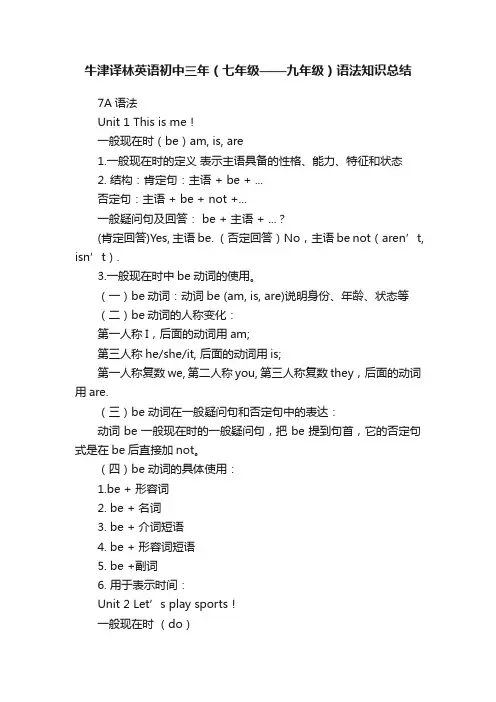
牛津译林英语初中三年(七年级——九年级)语法知识总结7A语法Unit 1 This is me!一般现在时(be)am, is, are1.一般现在时的定义表示主语具备的性格、能力、特征和状态2. 结构:肯定句:主语 + be + ...否定句:主语 + be + not +...一般疑问句及回答: be + 主语 + ...?(肯定回答)Yes, 主语 be. (否定回答)No,主语 be not(aren’t, isn’t).3.一般现在时中be动词的使用。
(一)be动词:动词be (am, is, are)说明身份、年龄、状态等(二)be动词的人称变化:第一人称I,后面的动词用am;第三人称he/she/it, 后面的动词用is;第一人称复数we, 第二人称you, 第三人称复数they,后面的动词用are.(三)be 动词在一般疑问句和否定句中的表达:动词be一般现在时的一般疑问句,把be提到句首,它的否定句式是在be后直接加not。
(四)be 动词的具体使用:1.be + 形容词2. be + 名词3. be + 介词短语4. be + 形容词短语5. be +副词6. 用于表示时间:Unit 2 Let’s play sports!一般现在时(do)1. 定义:表示经常的或习惯性的动作;表示客观真理或事实;表示目前的爱好、能力。
2. 常见时间短语:often, sometimes, usually, always, every week, on Sundays, once a month 等3. 结构:肯定句:主语 +V. + ...否定句:主语 + do/ does+ not + V. +...一般疑问句及回答: Do/Does + 主语 + ...?(肯定回答)Yes, 主语 do/ does. (否定回答)No,主语 do/does not(don’t, doesn’t).4. 第三人称单数形式及其变化规则当主语是第三人称单数时,谓语动词要用第三人称单数形式(三单)动词变化规则:(1).规则动词 + s,如makes, eats(2).s,sh,ch, ss, x 结尾 + es,如teaches, misses, fixes, finishes(3).辅音字母 + y结尾,把y 改为 ies,如carries, cries(4).特殊变化,如go--- goes, do --- does, have--- hasUnit 3 Welcome to our school!人称代词1. 定义:代替人或物的名词2. 人称代词的主宾格在句子中做的成分(1)人称代词的主格在句子中做主语,一般位于句首。
初中英语语法总结一览表 语法项目 构 成 用 法 象 征 词 规则变化 不规则变化 例 句
一般现在时 动词用原形 三人称单数-s / es
表示经常性的 动作或状态 Every often always on 天 in月、季、节、年。 一般-s –es 辅音+y---ies have----has He goes to school every day.
I often have lunch at home.
一般过去时 动词用过去时 Be—was/ were 表过去某个、段时间内动作及状态 ago/just now /In1998 last/yesterday 等 一般/去e 双写/辅+y结尾-ied go-went come-came do-did leave-left等 He wrote a letter yesterday. I studied hard last year.
一般将来时 be going to+V原 will / shall + V原 在将来某个时间或 某段时要做的事 tomorrow / after next / tonight in 2010 Go come leave stay fly等用进行表将来 Are you going to read ? He is coming tomorrow .
现在进行时 be+doing 表此时此刻正进行的动作或状态 listen look now all the time Don’t… 一般去e 双写 +ing tie die lie – 变ie为y加ing Tom is writing now . They are lying on the bed .
现在完成时 现在完成进行 have / has +PP have/has been+doing 发生在过去影响在现在的动作或状态等
含糊的频率副词 already just never ever 分词规则的同过去式是一样的 不规则的动词的过去分词需逐个记忆 I have been teaching for 8 years. He has slept for two days.
.过去进行时 was / were +doing 多用于复合句表在过去某时间正在进行的动作
at this time yesterday last Sunday evening 一般去e 双写 +ing tie die lie – 变ie为y加ing He was reading at that
time last Friday 语法项目 构 成 用 法 象 征 词 规则变化 不规则变化 例 句 中
过去完成时 had+动过去分词 多用于复合句中 该动作发生在过去的过去 by the time+过去时 when after before 规则的分词构成与过去时一样的 需要逐个记忆 详见不规则动词表 We had learnt 2000 words by the end of last year.
过去将来时 would + V 原形 多用宾语从句中 过去看来将要发生的动作或状态 He said that he… the next day . He said that he would come here the next day .
比较级形式 形容副词名词
后--er 前加more 名词比较用more 表示两个人、物 之间进行比较时 than /much/ a little far / in the two 等 一般/去e 双写/辅+y结尾-ier good/well —better much/many—more She is the tall in the two. He runs faster than Tom .
最高级形式 形容副词名词
后-est 前加most 名词比较用most 大于等于三个人、物之间进行比较 in the +比较范围 of the 具体的数字 一般/去e 双写/辅+y结尾-iest bad/ill/badly-worst far-farther-farthest She is the most beautiful in her class.(最高级加the) 动词不定式 to do没有人称和数的变化 作主语 To read is helpful for anybody now . 作宾语 He wants to buy a dictionary. 作宾补 I hear him sing yesterday Tom told me to open it. 作表语 His job is to take care of children . 作状语 He’ll go to see a doctor tomorrow . 作定语 He has much homework to do every day . 语法项目 构 成 用 法 象 征 词 规则变化 不规则变化 例 句 主从复合句 状语从句 句子作状语 (时间地点原因条件让步比较) He was writing a letter when I came in。 宾语从句 句子作宾语(语序、时态、引导词、客观事实) He asked me if I had been to Beijing before. 定语从句 句子作定语(修饰名词或代词的句子、注意先行词) I saw the man who was stealing my bike yesterday
主动结构 与 被动结构 主动语态:主语(人、物)+ 谓语 + 宾语 动作执行者 + 及物动词 + 动作承受者 被动语态:主语(人、物)+be PP + by宾语 动作承受者 + be PP + by动作执行者 在被动语态中没有可以省to 的不定式 We speak English . 主语 谓语 宾语 English is spoken by us 宾改主 谓语动词 be PP 主by 宾 主动变被动,先找主、谓、宾,宾改主、主by宾,代词变格要细心,谓语动词be pp,时态随主、数随被 PP 是及物动词的过去分词加ed 或不规则详见表 被动句的时态(be)随主动句的时态(do)人称和数应随被动句的主语(am、is、are、was、were等 )
Ⅰ. 初中英语八种时态归纳复习 时态是英语学习中一个至关重要的内容,广大初中学生在实际运用时,往往对时态总是倍感棘手,下面我们就归纳复习一下這几种时态。 一、一般现在时: 概念:经常、反复发生的动作或行为及现在的某种状况。 时间状语: always, usually, often, sometimes, every week (day, year, month…), once a week, on Sundays, etc. 基本结构:①be动词;②行为动词 否定形式:①am/is/are+not;②此时态的谓语动词若为行为动词,则在其前加don't,如主语为第三人称单数,则用doesn't,同时还原行为动词。 一般疑问句:①把be动词放于句首;②用助动词do提问,如主语为第三人称单数,则用does,同时,还原行为动词。 二、一般过去时: 概念:过去某个时间里发生的动作或状态;过去习惯性、经常性的动作、行为。 时间状语:ago, yesterday, the day before yesterday, last week(year, night, month…), in 1989, just now, at the age of 5, one day, long long ago, once upon a time, etc. 基本结构:①be动词;②行为动词 否定形式:①was/were+not;②在行为动词前加didn't,同时还原行为动词。 一般疑问句:①was或were放于句首;②用助动词do的过去式did 提问,同时还原行为动词。 三、现在进行时: 概念:表示现阶段或说话时正在进行的动作及行为。 时间状语:now, at this time, these days, etc. 基本结构:am/is/are+doing 否定形式:am/is/are+not+doing. 一般疑问句:把be动词放于句首。 四、过去进行时: 概念:表示过去某段时间或某一时刻正在发生或进行的行为或动作。 时间状语:at this time yesterday, at that time或以when引导的谓语动词是一般过去时的时间状语等。 基本结构:was/were+doing 否定形式:was/were + not + doing. 一般疑问句:把was或were放于句首。 五、现在完成时: 概念:过去发生或已经完成的动作对现在造成的影响或结果,或从过去已经开始,持续到现在的动作或状态。 时间状语:recently, lately, since…for…,in the past few years, etc. 基本结构:have/has + done 否定形式:have/has + not +d one. 一般疑问句:have或has。 六、过去完成时: 概念:以过去某个时间为标准,在此以前发生的动作或行为,或在过去某动作之前完成的行为,即“过去的过去”。 时间状语:before, by the end of last year(term, month…),etc. 基本结构:had + done. 否定形式:had + not + done. 一般疑问句:had放于句首。 七、一般将来时: 概念:表示将要发生的动作或存在的状态及打算、计划或准备做某事。 时间状语:tomorrow, next day(week, month, year…),soon, in a few minutes, by…,the day after tomorrow, etc. 基本结构:①am/is/are/going to + do;②will/shall + do. 否定形式:①was/were + not; ②在行为动词前加didn't,同时还原行为动词。 一般疑问句:①be放于句首;②will/shall提到句首。 八、过去将来时: 概念:立足于过去某一时刻,从过去看将来,常用于宾语从句中。 时间状语:the next day(morning, year…),the following month(week…),etc. 基本结构:①was/were/going to + do;②would/should + do. 否定形式:①was/were/not + going to + do;②would/should + not + do. 一般疑问句:①was或were放于句首;②would/should 提到句首。 Ⅱ. 几种常見时态的相互轉换 英语中的几种时态在一定情况下可以互相轉换,以下是几种常見的轉换形式: 一、一般过去时与现在完成时的轉换 在现在完成时中,延续性动词能与表示一段时间的状语連用,瞬间动词却不能。但是,可用別的表达方式:①瞬间动词用于“一段时间 + ago”的一般过去时的句型中;②瞬间动词可改成与之相对應的延续性动词及短语,与一段时间連用;③瞬间动词用于“It is + 一段时间 + since + 一般过去时”的句型中,表示“自从……以来有……时间”的意思,主句一般用it is来代替It has been;④